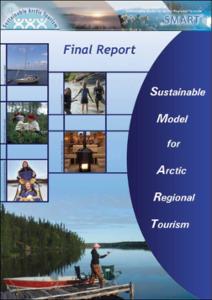| dc.contributor.author | Vaarala, Mirkka | |
| dc.coverage.spatial | Arctic Region | en_US |
| dc.date.accessioned | 2022-06-29T21:10:47Z | |
| dc.date.available | 2022-06-29T21:10:47Z | |
| dc.date.issued | 2006 | |
| dc.identifier.citation | Vaarala, M. (2006) Final report. Sustainable model for Arctic Regional Tourism. Rovaniemi, Finland, State Provincial Office of Lapland and Kemi-Tornio University of Applied Sciences, 43pp. DOI: http://dx.doi.org/10.25607/OBP-1773 | en_US |
| dc.identifier.uri | https://repository.oceanbestpractices.org/handle/11329/1972 | |
| dc.identifier.uri | http://dx.doi.org/10.25607/OBP-1773 | |
| dc.description.abstract | he purpose of the Sustainable model for Arctic Regional Tourism (SMART) – project was to assist the arctic tourism sector, mainly local small- to medium-sized tourism businesses (SMEs) and other local stakeholders to develop positive economic, social and environmental benefits from tourism based on the cultural and natural environment of the North. The project’s goal was to create resources, tools and incentives that can be used by northern and arctic tourism SMEs and other local players in tourism development as well as to create professional training to assist the tourism sector in their respective area. During the SMART -project, six basic principles for sustainable arctic tourism were created from existing principles and other sources of information. Based on the principles, a Trainer’s manual containing six training modules of sustainable tourism were created for the tourism companies. Interviews were made within the project’s pilot tourism companies and good business practises collected on actions that represent sustainable tourism, as it is defined in this project via the sustainable arctic tourism principles and their guidelines. Plans for a common arctic sustainable tourism label were made during the project and the partners decided to recommend using the Swedish ecotourism label, Nature’s Best, as a model for the Arctic countries and regions to be adapted for the tourism industry. An initial review of the model was done in northern Finland, in Nunavut and North-West Territories of Canada as well as in Kamchatka, Russia. The model has also been introduced to the Alaskan tourism industry. The Sustainable Arctic Tourism Association (SATA) was established in October 2005 to continue the development and promotion of sustainable tourism in the Arctic and to formalize the circumpolar network of tourism stakeholders that has been built up over the past several years. The association provides a forum for sustainable arctic tourism operators and other stakeholders to share their expertise and opinions. | en_US |
| dc.description.sponsorship | Arctic Council's Sustainable Development Working Group | en_US |
| dc.language.iso | en | en_US |
| dc.publisher | State Provincial Office of Lapland and Kemi-Tornio University of Applied Sciences, Finland. | en_US |
| dc.subject.other | Tourism | en_US |
| dc.subject.other | Sustainable tourism | en_US |
| dc.subject.other | Economic development | en_US |
| dc.title | Final Report. Sustainable model for Arctic Regional Tourism. | en_US |
| dc.type | Report | en_US |
| dc.description.status | Published | en_US |
| dc.format.pages | 43pp. | en_US |
| dc.contributor.corpauthor | Sustainable Model for Arctic Regional Tourism (SMART) | en_US |
| dc.publisher.place | Rovaniemi, Finland | en_US |
| dc.subject.parameterDiscipline | Cross-discipline | en_US |
| dc.subject.parameterDiscipline | Human activity | en_US |
| dc.description.currentstatus | Current | en_US |
| dc.description.sdg | 8.2 | en_US |
| dc.description.methodologyType | Reports with methodological relevance | en_US |
| obps.contact.contactemail | nflapland:llh.intermin.fi | |
| obps.resourceurl.publisher | http://hdl.handle.net/11374/33 | |
 Repository of community practices in Ocean Research, Applications and Data/Information Management
Repository of community practices in Ocean Research, Applications and Data/Information Management
